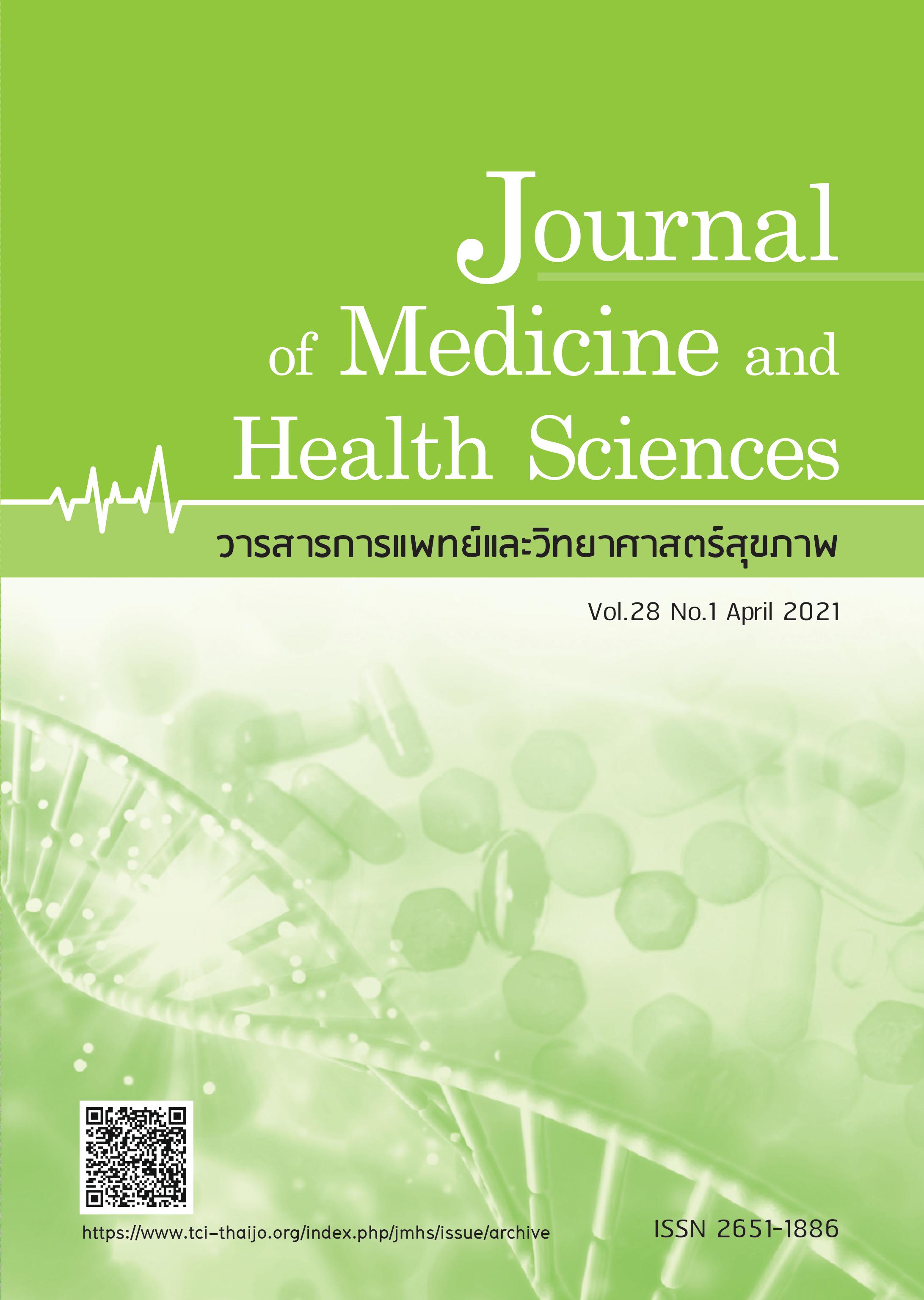Safety of a high absorption pad for blood and pus with silk sericin and chitosan
Keywords:
high absorption pad, blood and pus, silk sericin, chitosan, safetyAbstract
High absorption pad for blood and pus with silk sericin and chitosan was developed to enhance absorption properties and non-adhesion. It reduced pain while dressing and had anti-bacterial property identical to Bactigras®. This study is the clinical evaluation of the high absorption pad for blood and pus with silk sericin and chitosan to confirm its safety in comparison with Bactigras® (control group, standard treatment) which requires investigation before clinical efficacy evaluation. The safety test was conducted on 100 healthy volunteers and performed using a patch model. The induction phase used a high absorption pad for blood and pus with silk sericin and chitosan and Bactigras® for six days then removed the dressing for 7-10 days. After that, the dressing was repeated for 3 days (challenge phase). The erythema index and melanin index were evaluated for skin inflammation and post-inflammation hyperpigmentation. There was no significant increase in erythema and the melanin index between each phase. There was evidence of mild erythema and itching on the skin patched with a high absorption pad for blood and pus with silk sericin and chitosan and Bactigras® and no evidence of severe cutaneous reactions was found. Therefore, these results confirmed that a high absorption pad for blood and pus with silk sericin and chitosan was safe for the treatment of wound.
References
2. Heyer K, Augustin M, Protz K, et al. Effectiveness of advanced versus conventional wound dressings on healing of chronic wounds: systematic review and meta-analysis. Dermatology 2013;226: 172-84.
3. Sorensen LT. Wound healing and infection in surgery: the pathophysiological impact of smoking, smoking cessation, and nicotine replacement therapy: a systematic review. Ann Surg 2012;255:1069-79.
4. Aramwit P, Palapinyo S, Srichana T, et al. Silk sericin ameliorates wound healing and its clinical efficacy in burn wounds. Arch Dermatol Res 2013;305:585-94.
5. Shitole M, Dugam S, Tade R, et al. Pharmaceutical applications of silk sericin. Ann Pharm Fr 2020;78:469-86.
6. Chouhan D, Mandal BB. Silk biomaterials in wound healing and skin regeneration therapeutics: From bench to bedside. Acta Biomater 2020;103:24-51.
7. Aramwit P, Angkasirisap W, Srichana T. The effect of silk sericin protein on collagen production and skin wound healing in rats (Thai). APSJ 2009;14:460-70. (in thai)
8. Matica MA, Aachmann FL, Tøndervik A, et al. Chitosan as a Wound Dressing Starting Material: Antimicrobial Properties and Mode of Action. Int J Mol Sci 2019;20(23).
9. Raafat D, von Bargen K, Haas A, et al. Insights into the mode of action of chitosan as an antibacterial compound. Appl Environ Microbiol 2008;74:3764-73.
10. Helander IM, Nurmiaho-Lassila EL, Ahvenainen R, et al. Chitosan disrupts the barrier properties of the outer membrane of gram-negative bacteria. Int J Food Microbiol 2001;71:235-44.
11. Galván Márquez I, Akuaku J, Cruz I, et al. Disruption of protein synthesis as antifungal mode of action by chitosan. Int J Food Microbiol 2013;164:108-12.
12. Xing K, Chen XG, Liu CS, et al. Oleoylchitosan nanoparticles inhibits Escherichia coli and Staphylococcus aureus by damaging the cell membrane and putative binding to extracellular or intracellular targets. Int J Food Microbiol 2009;132:127-33.
13. Rabea EI, Badawy ME, Stevens CV, et al. Chitosan as antimicrobial agent: applications and mode of action. Biomacromolecules 2003;4:1457-65.
14. Champer J, Patel J, Fernando N, et al. Chitosan against cutaneous pathogens. AMB Express 2013;3:37.
15. Tayel AA, Moussa S, Opwis K, et al. Inhibition of microbial pathogens by fungal chitosan. Int J Biol Macromol 2010;47:10-4.
16. McNamee PM, Api AM, Basketter DA, et al. A review of critical factors in the conduct and interpretation of the human repeat insult patch test. Regul Toxicol Pharmacol 2008;52:24-34.
17. Hasatsri S, Angspatt A, Aramwit P. Randomized Clinical Trial of the Innovative Bilayered Wound Dressing Made of Silk and Gelatin: Safety and Efficacy Tests Using a Split-Thickness Skin Graft Model. Evid Based Complement Alternat Med 2015;2015:206871.
18. Maenthaisong R, Chaiyakunapruk N, Warnnissorn P, et al. Cleansing lotion containing tamarind fruit pulp extract. III. Study of lightening efficacy and skin irritation on Asian skin type. ScienceAsia 2009;35:24-30.
19. Siritientong T, Angspatt A, Ratanavaraporn J, et al. Clinical potential of a silk sericinreleasing bioactive wound dressing for the treatment of split-thickness skin graft
donor sites. Pharm Res 2014;31:104-16
20. Napavichayanun S, Yamdech R, Aramwit P. The safety and efficacy of bacterial nanocellulose wound dressing incorporating sericin and polyhexamethylene biguanide:
in vitro, in vivo and clinical studies. Arch Dermatol Res 2016;308:123-32.
21. Maenthaisong R, Viyoch J, Chaiyakunapruk N, et al. Cleansing lotion containing tamarind fruit pulp extract. II. J Cosmet Dermatol 2007;6:178-82.



